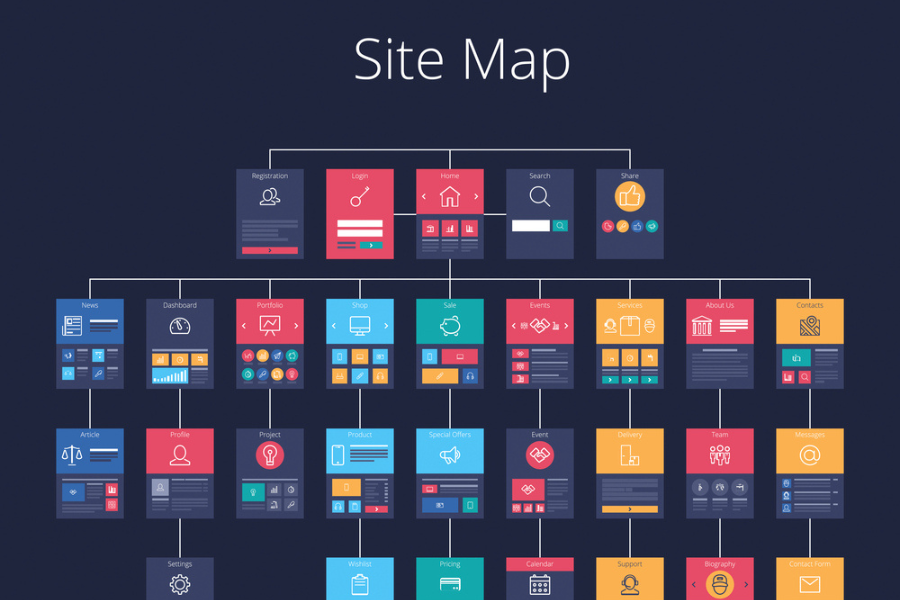Imagine walking into a department store looking for a pair of shoes, only to find that men's clothing is mixed with women's accessories, children's toys are in the kitchen section, and nobody seems to know where anything is. That’s what it’s like for a user navigating a website without a well-organized sitemap.
A well-crafted sitemap serves as your website's blueprint. It ensures visitors can easily find what they're looking for without wandering aimlessly. It's a powerful tool that can elevate your small business in multiple ways.
What Is A Sitemap and Why Does Your Small Business Need One?
So, what exactly is a sitemap? In basic terms, a sitemap is a list or diagram that shows the organization of your website's content. Think of it like the index in the back of a book, pointing you to where you can find what you're looking for.
Now, how does it work for SEO (Search Engine Optimization)? A sitemap gives search engines a guide to all the pages on your website, making it easier for them to index your content.
But it's not just about SEO. A sitemap also plays a crucial role in user experience (UX). It lays the foundation for your website structure, allowing your visitors to find the information they need effortlessly. And let’s face it, a happy visitor is much more likely to become a happy customer.
As a small business owner, you can’t afford to overlook the power of a well-crafted sitemap. It's like having a 24/7 customer service agent who not only welcomes visitors to your store but also shows them exactly where to go.
Web Design and Its Relationship With Sitemaps
You might wonder, "Isn't web design all about making a website look good?"
While aesthetics are indeed important, effective web design goes beyond just visual appeal. It incorporates site navigation, functionality, and yes, sitemaps. Site navigation is closely tied to your sitemap. A logical, easy-to-follow navigation based on a well-structured sitemap can significantly improve user experience. Just like a well-organized store makes shopping enjoyable, a well-designed website keeps visitors engaged.
Your sitemap also affects website performance. A messy site structure can slow down your website, frustrating visitors and negatively impacting your search engine ranking. In contrast, a clean, well-organized sitemap can enhance the speed and performance of your website, contributing to better UX design.
Internal Linking: The Silent Hero of SEO
Now, let's talk about something that’s often overlooked but crucial: internal linking. These are the links that connect one page of your website to another. A well-crafted sitemap provides a roadmap for effective internal linking. By clearly identifying how your website's content is related, you can strategically place internal links to guide your visitor through a journey from awareness to conversion.
Remember, search engines love websites that provide value. An effective internal linking strategy, guided by a good sitemap, can increase the time visitors spend on your site. More time spent means lower bounce rates, higher engagement, and improved search engine ranking.
Mobile-Friendly Websites: Why Your Sitemap Should Be Responsive
In today's digital age, mobile optimization is non-negotiable. According to data, a large chunk of web traffic comes from mobile devices. But how does this relate to your sitemap?
A mobile-friendly website isn’t just about responsive design; it’s also about having a mobile-responsive sitemap. Your sitemap should work seamlessly across different devices to ensure that the user experience is consistent, whether someone visits your site from a laptop, tablet, or smartphone.
Remember, Google uses mobile-first indexing, which means it predominantly uses the mobile version of a site for ranking and indexing. A mobile-friendly sitemap helps in improving your website's performance on search engines, thereby increasing organic traffic.

Site Architecture and Its Role in User Experience
Site architecture refers to how your website is structured. It’s the backbone of your website, and it’s closely related to your sitemap. A well-designed site architecture guided by a well-crafted sitemap can significantly enhance user experience (UX Design).
Think of your website as a house. If the architecture is sound, the house is strong, inviting, and functional. Your sitemap is like the blueprint that guides this architecture, making sure every room (or page) is where it should be.
Investing in sound site architecture can go a long way in boosting your website optimization efforts. It not only improves navigation but also increases your website's loading speed — a significant factor in search engine ranking.
Content Strategy: How a Sitemap Helps You Plan Better
You’ve probably heard the saying, "Content is king." While that’s true, even the best content can get lost if your website structure is a maze. That’s where your sitemap comes into play, helping you plan a solid content strategy.
A well-crafted sitemap allows you to see the bigger picture, enabling you to organize your content in a way that aligns with your business goals and user needs. This makes it easier to plan future content, ensuring that each new piece fits perfectly into the existing structure.
By mapping out where each type of content will reside, you make it easier for search engines to understand the purpose of each page, boosting your search engine ranking. A solid content strategy, backed by a well-crafted sitemap, is a win-win for both your users and your SEO.
Crafting Your Sitemap — A Small Investment, Big Returns
Remember, your website is often the first interaction customers have with your business. A good sitemap ensures that this first impression is not only positive but also leaves your visitors eager to explore more. Think of it as your website’s GPS—it helps guide users where they need to go while also telling search engines what your site is all about.
At Eternity, we pride ourselves on creating sitemaps that make your site easy to use and improve the overall experience for your visitors. If you have questions – we’re always here to chat! We look forward to hearing from you.

